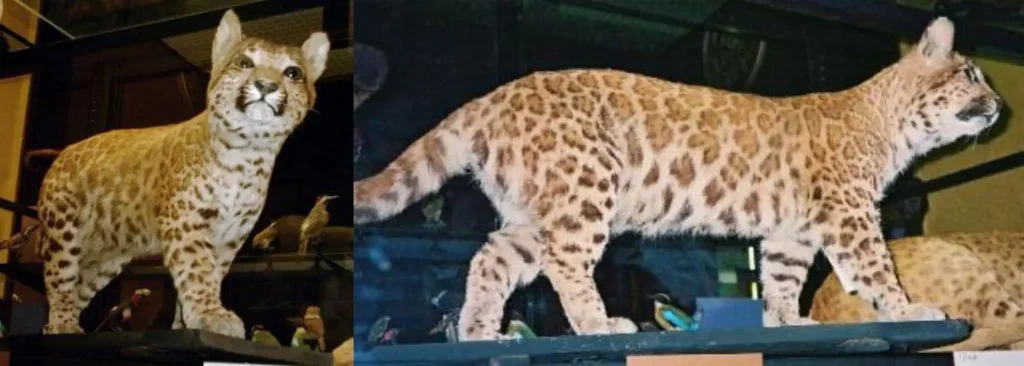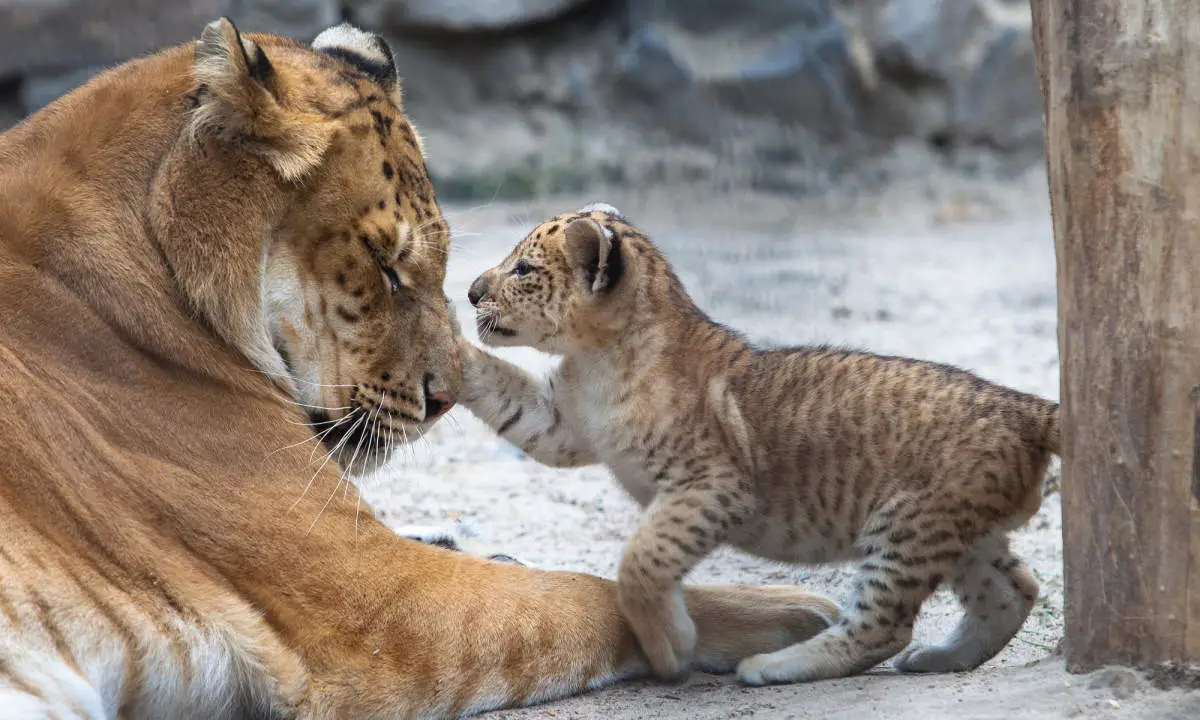Four of the five species of the big cats (the Panthera genus – lion, tiger, leopard, jaguar, and snow leopard), the exception being the snow leopard can hybridize with each other to produce numerous hybrids. In fact, most of these animals’ habitats do not overlap, for example, lions live in Africa and tigers in Asia. However, hybrid big cats can be born by accident in captivity.
It’s worth noting that hybridization between different species is generally frowned upon by many conservationists and animal welfare advocates, as it can lead to various negative consequences, including the loss of genetic diversity, the spread of disease, and the production of animals that are poorly adapted to their environments or suffer from various health problems.
Here
Liger: the largest of the hybrid big cats
Father: Lion, Mother: Tiger

Tawny, golden, and white forms. Ligers are the largest of all known extant felines.
Ligers enjoy swimming, which is a characteristic of tigers, and are very sociable like lions. Ligers (and tigons) exist only in captivity because the habitats of the parental species do not overlap in the wild. Historically, when the Asiatic Lion was prolific, the territories of lions and tigers did overlap and there are legends of ligers existing in the wild.
A male liger named Nook at the Valley of the Kings Animal Sanctuary in Wisconsin who died in 2007 weighed over 550 kg (1,213 lb). This is a huge weight for a big cat, even for a liger. It is believed that he was probably the largest and biggest cat ever to live on Earth.

According to the Liger World website, Nook was abandoned by its owners when it was around 3 and a half months old. It is very common within the USA to abandon big cats because they grow so big that it becomes almost impossible for their owners to fulfill their food consumption and care.
He was transferred to the animal sanctuary at the age of 4 months. He weighed over 550 kg (1,213 lb), and probably up to 615 kg (1,400 lb). This is a huge weight for a big cat, even for a liger. It is believed that he was probably the largest and biggest cat ever to live on Earth. At the age of 21 Nook was euthanized to death because of cancer.
Contrary to the common myth, the liger cubs don’t possess a risk for their mother tiger during birth. Liger cubs are of the same size as the tiger cubs at the time of birth, and a tigress (female tiger) can easily deliver them on her own, according to the Liger World website.


Related: 20 Amazing Liger Facts
Tigon
Father: Tiger, Mother: Lion
Alternative names: tion, tigron, tiglon

A tigon is a hybrid cross between a male tiger (Panthera tigris) and a female lion (Panthera leo). Thus, it has parents with the same genus but of different species. The tigon is not currently as common as the converse hybrid, the liger. The tigon’s genome includes genetic components of both parents.
Tigons can exhibit visible characteristics from both parents: they can have both spots from the mother (lions carry genes for spots-lion cubs are spotted and some adults retain faint markings) and stripes from the father. Any mane that a male tigon may have will appear shorter and less noticeable than a lion’s mane and is closer in type to the ruff of a male tiger.
It is a common misconception that tigons are smaller than lions or tigers. They do not exceed the size of their parent species because they inherit growth-inhibitory genes from the lioness mother, but they do not exhibit any kind of dwarfism or miniaturization; they often weigh around 180 kilograms (400 lb).

Related: Top 5 Largest Prehistoric Cats
Liliger
Father: Lion, Mother: Liger
The liliger is the hybrid offspring of a male lion and a female liger. Male tigons and ligers are sterile, but female ligers and tigons can produce cubs. The first liliger was born in 1943 at the Hellabrunn Zoo in Germany.
Ligers and tigons are both relatively common in captivity, but liligers are much rarer since they require a male lion and a female liger to mate. In fact, as far as we know, there are only a few documented cases of liligers in existence.
Like other big cat hybrids, liligers tend to exhibit a combination of physical traits from both parent species. For example, they may have a lion’s mane but tiger stripes, or a lion’s body with tiger-like facial markings.
Liligers usually grow bigger than tigers and lions.
Litigon
Father: Lion, Mother: Tigon
A litigon is a rare, second-generation hybrid of a female tigon and a male lion, specifically an Asiatic lion.
The first litigon, a female cub was born at the Alipore Zoo in Calcutta, India in 1971 to a female tigon named Rudhrani and an Asiatic lion named Debabrata.
Rudhrani went on to produce seven litigons, and some of them reached impressive sizes: a litigon named Cubanacan (died 1991) was estimated to weigh at least 362 kilograms (798 lb), stood 1.32 meters (4 feet 4 inches) at the shoulder, and was 3.5 meters (11 feet) in total length.

Tiliger
Father: Tiger, Mother: Liger
Alternative name: Tig-liger
A tiliger is the offspring of a male tiger and a ligress (female liger). They mostly look like tigers. World’s first tiliger cub was born in 2007 at the Greater Wynnewood Exotic Animal Park, alternatively known as the G.W. Zoo in Oklahoma, United States.
Like liligers, tiligers can grow bigger than lions and tigers. So, the ligers are the biggest cats in the world and then come tiligers and liligers which are also bigger than lions and tigers.
Titigon
Father: Tiger, Mother: Tigon
Alternative name: Tig-tigon
A titigon is the offspring of a male tiger and a tigoness (female tigon). They look more tiger-like.
Tigard
Father: Tiger, Mother: Leopard
Alternative name: Tipard
In 1900, Carl Hagenbeck (10 June 1844 – 14 April 1913), a German merchant of wild animals who supplied many European zoos, crossed a female leopard with a Bengal tiger. The stillborn offspring had a mixture of spots, rosettes, and stripes. Henry Scherren wrote, “A male tiger from Penang served two female Indian leopards, and twice with success. Details are not given and the story concludes somewhat lamely. ‘The leopardess dropped her cubs prematurely, the embryos were in the first stage of development and were scarcely as big as young mice.’ Of the second leopardess, there is no mention.”
According to a report in a 1978 edition of the British tabloid paper “Sun”, a “
Unlike earlier attempts at captive-breeding leopard-tiger hybrids, this purported hybrid evidently survived into adulthood. Eventually, the Southam Zoo
Pumapard
Father: Puma, Mother: Leopard

In the late 1890s/early 1900s, two pumapards were born in Chicago, USA, followed 2 years later by three sets of twin cubs born at a zoo in Hamburg, Germany from a puma father and leopard mother.
Carl Hagenbeck also apparently bred several litters of puma x leopard hybrids in 1898 at the suggestion of a menagerie owner in Britain; this was possibly Lord Rothschild (as one of the hybrids is preserved in his museum) who may have heard of the two hybrid cubs bred in Chicago in 1896 and suggested Hagenbeck reproduced the pairing.
Today, there are no living pumapards in the world. It’s impossible pumapards to be born in the wild.

Leopon
Father: Leopard, Mother: Lion
Alternative name: Lepon
A leopon is the hybrid offspring of a male leopard and a female lion. These hybrid big cats have a head that resembles that of a lion, while the rest of their body exhibits similarities to leopards.
In 1910, the first recorded leopon was bred at Kolhapur, India. British entrepreneur and naturalist Walter Samuel Millard (1864-1952), the Secretary of the Bombay Natural History Society, sent its skin to the British zoologist Reginald Innes Pocock (4 March 1863 – 9 August 1947). This leopon was the result of breeding a large leopard with a lioness, and two cubs were born from this mating.
Unfortunately, one of the cubs died at 2.5 months of age, while the other was still alive when Pocock described it in 1912. Pocock observed that the leopon had leopard-like spots, although they were smaller and closer together than those of an Indian leopard. The spots were brown and indistinct, similar to the fading spots of a juvenile lion.

The leopon’s head, spine, belly, and legs had black and distinct spots, while its tail was spotted on the top and striped underneath with a blackish tip and longer hairs. The leopon’s underside was dirty white, and its ears were fawn with a broad black bar, lacking the white spot found in leopards. Pocock noted that the lijagulep, or Congolese spotted lion, bred in Chicago was the closest hybrid he had previously seen to this type.
More recently, observations from Japanese cats at the Nishinomiya City Zoo have revealed that leopons are larger than leopards and exhibit traits from both leopards and lionesses. They have brown spots rather than black, and their tails are tufted. They enjoy climbing like leopards and are also fond of water. Male leopons may have sparse manes of around 20 cm in length.
Jagulep
Father: Jaguar, Mother: Leopard
Alternative names: Jagupard, Jagleop
A jagulep is a hybrid of a jaguar and a leopardess (female leopard). A single rosetted female jagulep was produced at a zoo in Chicago (America). Jaguar-leopard hybrids bred at Hellbrun Zoo, Salzburg were described as jagupards.
Lijagulep [Congolese spotted lion]
A lijagulep is a hybrid of a male lion and a female jagulep.
Possibly at the Lincoln Park Zoo in Chicago, three hybrids of jaguar and leopardess were bred. These hybrids were sold to a traveling menagerie, and one was exhibited at the London Zoo and White City in London. Initially, the female jaguleps rejected mating with a leopard, but one of them was eventually mated with a lion and produced multiple litters.
In 1908, one of the offspring was displayed in London and was claimed to be a type of lion (Congolose spoted lion). that name was most likely given by a showman because the public was more interested in exotic captured animals than in captive-bred hybrids. It was similar in size to a lioness and had brown rosettes or spots. It is unclear whether the other lijagulep cubs survived into adulthood.
Liard
Father: Lion, Mother: Leopard
Alternative name: Lipard
A liard is a proper term for a hybrid of a male lion with a leopardess (female leopard). A liard was born in Schoenbrunn Zoo, Vienna in 1951.
Caraval
Father: Caracal, Mother: Serval
The caraval (also called a cara-serval) is the hybrid cross between a male caracal and a female serval. They have a spotted pattern similar to the serval but on a darker background.

Servical
Father: Serval, Mother: Caracal
A servical is the cross between a male serval and a female caracal. A litter of servicals occurred by accident when the two animals were kept in the same enclosure at Los Angeles Zoo. The hybrids were given to an animal shelter.
Sources
- Panthera hybrid on Wikipedia
- Ligers, tigons, and hybrids on crownridgetigers.com
- Tigon on Wikipedia
- Liliger on Wikipedia
- Litigon on Wikipedia
- Hybrids between leopards and tigers on messybeast.com
- Pumapard on Wikipedia
- Pumapards – Everything You Wanted To Know About The Puma/Leopard Hybrid on the Ned Hardy website
- Leopon on Wikipedia
- Congolese spotted lion on Wikipedia
- Moon Landings: All-Time List [1966-2025] - February 2, 2025
- What Is Max-Q and Why Is It Important During Rocket Launches? - January 16, 2025
- Top 10 Tallest Rockets Ever Launched [2025 Update] - January 16, 2025

2 replies on “Hybrid Big Cats [Ligers, Tigons, and more, with photos and videos!]”
has there ever been a lion and serval, serval and tiger, serval and leopard, serval and puma, caracal and lion, caracal and tiger, caracal and leopard, caracal and puma, and also, why re cheetahs not in the panthera genus?
[…] https://ourplnt.com/hybrid-big-cats/ […]